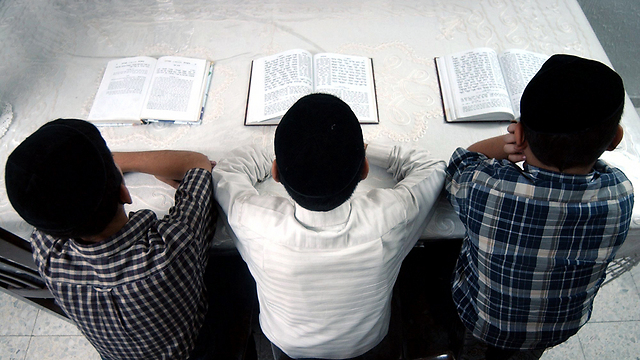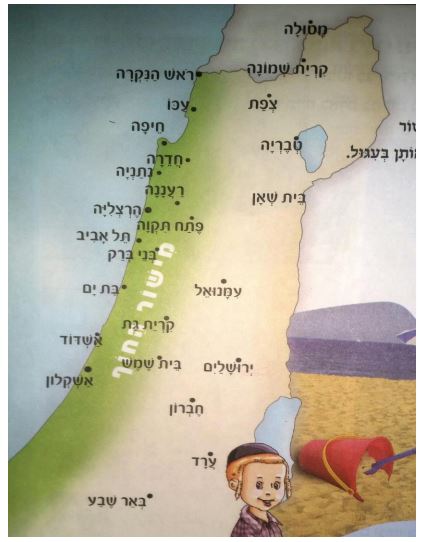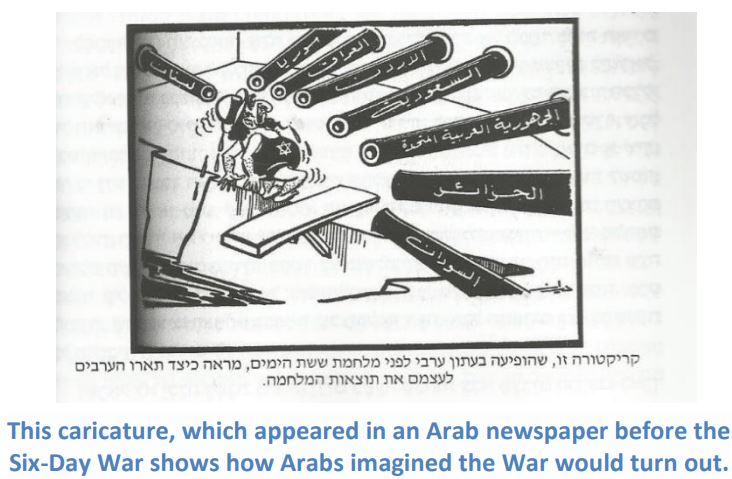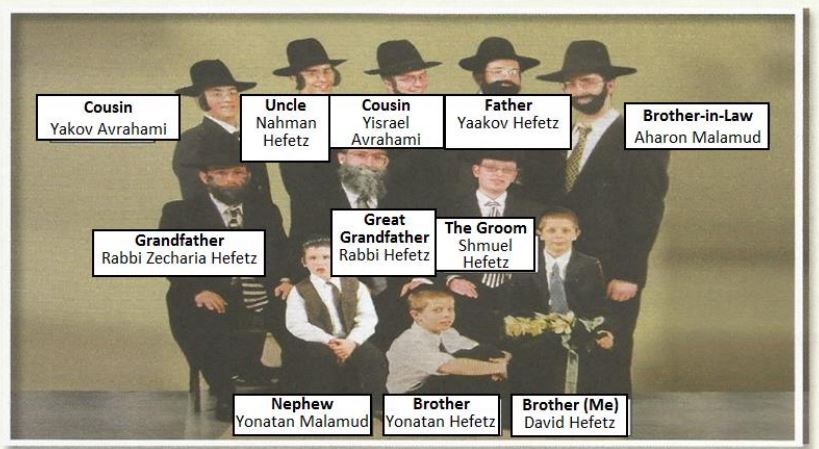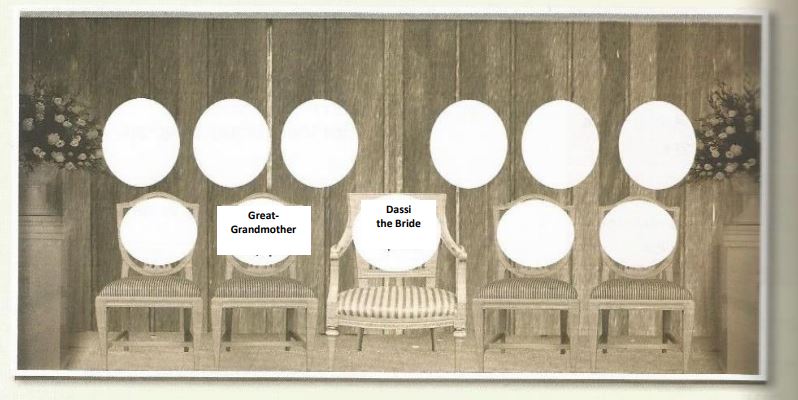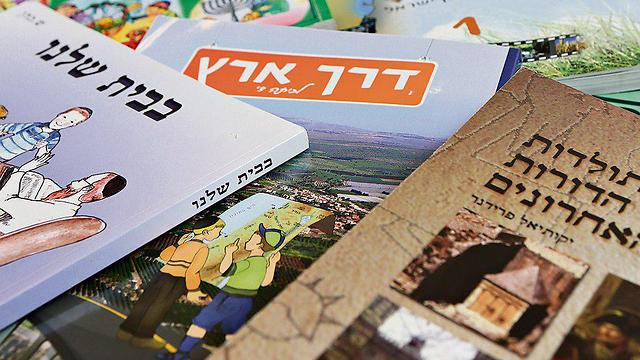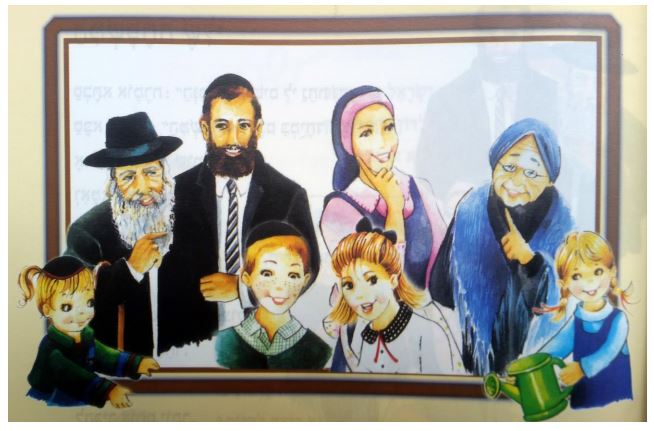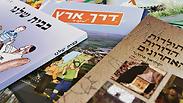
A look into Haredi textbooks shows hatred and racism
A study of almost 100 textbooks used in ultra-Orthodox education institutions finds exclusion of women and noticeable absence of Mizrahi Jews, even at Shas schools, while the leftists are to blame for the security situation and Zionists and Reformists are seen as the enemy.
The study, conducted by Dr. Eldad J. Pardo and Tehila Gamliel, reviewed almost a hundred textbooks used in Haredi schools to teach literature, history, geography, civics, science and Bible studies.
The study found scathing criticism of Zionism in ultra-Orthodox textbooks: "Late nineteenth century anti-Semitism led to cohesion within the ranks of the assimilators, who created their own organizations. These organizations gave great power to assimilated Jewry, which no one could withstand," according to History of Recent Generations, a textbook for middle school.
"Assimilation of individuals cannot harm the Jewish people as a whole... But when assimilation is a guiding principle of an entire public or organization that discards the people's values, it warps the image of the people in its entirety. That is what happened, for example, when the Zionist Organization was founded. This organization jettisoned most of the people's values and claimed to represent the people."
Furthermore, the founding of the State of Israel is described as a sin against the Jewish people: "When olim (Jewish immigrants) from Middle Eastern countries came to Israel, something happened that the Haredi community had feared when the state was founded. Political activists, Histadrut (National Workers' Union) and Jewish Agency emissaries, and other functionaries abused their power and (effectively) distanced the immigrants, especially their children, from their (Jewish) faith," the same middle school text book determines.
The 'hollowness' of secular education
Secular people, according to Haredi textbooks, applied any means necessary to secularize the new immigrants arriving in Israel. "They cut off the payot (side locks) of Yemenite children, claiming that they harbored lice; they withheld work arrangements from parents if they refused to send their children to secular schools; and deprived them of all other necessities, such as food, housing, and sanitary conditions," according to the History of Recent Generations textbook.
"At the center of every immigrant settlement they built a new and handsome building for secular cultural activity, while synagogues were set up in wretched sheds at the outskirts of the camps, so that only the old and sick would go there. In this way the children were cut off from their parents and from their parents' faith."
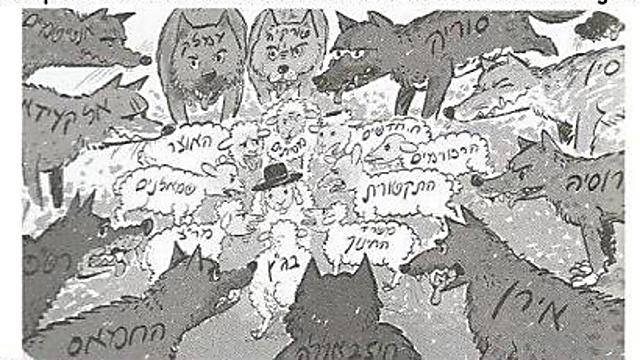
On secular education, the textbook's authors explain that, "During this period of fierce struggle over the Jewish character of every sphere of activity and every institution in Israel, the hollowness of secular education became obvious. The Ministry of Education director frankly admitted the failure of secular education, whose outcomes could be seen clearly in our generation, stripped bare of ideals and sunk in the depths of materialism... The academically educated also demonstrated the failure of secular education; many who did not manage to attain the 'affluent society' lifestyle, left the country."
One of the ultra-Orthodox's biggest adversaries, as the books portray him, is Moses Mendelssohn, a German Jewish philosopher and one of the forefathers of the Jewish Enlightenment Movement in the 18th century. "The Haskalah as instituted by Moshe Mendelssohn branched out in two ways: conversion from Judaism, and Reform Judaism. Those who took the first path were cut off from the Jewish nation's Tree of Life: they converted. Those who followed the second route tried to damage the tree itself, to corrupt and deform it through changes aimed at turning Judaism into a version of Christianity. These were the Reform Jews," the History of Recent Generations textbook states.
Later, the textbook refers to the Reform movement as "treacherous," "nasty," and "despicable."
Leftists are at fault, Arabs are dangerous
Haredi students learn that Jews have absolute right over the entire Land of Israel, as God promised Abraham. Textbooks in civics—a subject taught mostly to girls—show the ultra-Orthodox don't consider occupation to be unjust, but do believe the Palestinians, along with other non-Jewish residents of Israel, should be treated fairly and with caution.
"The liberation of the homeland is promised by the Creator of the Universe; it is not considered to be an 'occupation.' The only issue about which care must be taken is that of allowing the inhabitants to choose whether to remain in the land as foreign subjects, accepting the behavioral restrictions that would be imposed upon them, or to leave the land," according to the civics textbook As a New Citizen.
The Haredi textbooks almost entirely ignore the Israeli-Palestinians conflict and the question of the Palestinian national identity. According to the textbook's writers, Israeli Arabs are citizens with equal rights, "but they have not been content with this, and have insisted that they also have the right to identify with the Arabs of the Territories, those who call themselves 'Palestinians'—though the latter are enemies of the state," according to History of Recent Generations.
The textbook compares the dangers posed by these Arabs to "what happened in Germany when the Nazis came to power. The Nazis used democratic means, including general elections, to take control of Germany."
The Palestinian issue is mostly addressed in chapters dealing with what Haredi history textbooks describe as the greatest catastrophe to befall the State of Israel—the Oslo Accords.
History of Recent Generations describes the results of the accords, "The Israeli government gave them authority and political, economic and military power without concern for the destructive consequences that might result from placing such might in the hands of the monstrous PLO terrorists and the PLO's military arm, Fatah."
Later in the book, an article from the Haredi newspaper Hamodia is quoted: "They were given almost everything. They (the Palestinians) never were a distinct people and they never had a country of their own. We declared them a people and gave them a land. But the more we gave them, the more intensely hostile they became, and the more acts of murder they committed."
At fault for the Oslo disaster, according to Haredi textbooks, are the Israeli left-wing parties, who aided Yasser Arafat realize his evil plan and agreed to sign the agreement in September 1993 on the lawns of the White House.
"Arafat was in the worst possible situation, from every perspective. But at that very point the Israeli leftist political parties came to his aid. They assumed that the head of the PLO terrorist organization would prove to be a peace partner," History of Recent Generations accuses.
Empty chairs instead of women
In two other areas there were no surprises: the attitude towards women and science and scientific discoveries. Haredi textbooks on nature and science make no mention of Darwin's theory of evolution, but there is limited reference to important scientific discoveries, with an emphasis put on the religious and miraculous aspects. Behind every discovery stands the Creator, and clues can be found in the Bible for every invention.
Women, meanwhile, have seen a change in their status in recent years as they became the main providers in the Haredi home while the men went to study at the yeshiva. This is also how women are portrayed in ultra-Orthodox textbooks.
A poem in the textbook In Good Time for first graders describes "Mother" as one who "leads the home with wisdom and insight," but also one whose role is "To wash the dishes and listen to stories / To hang the laundry and sing us songs." Furthermore, the mother "respect(s) Father and serve(s) his plate first."
The father, meanwhile, is described as one who "understands many things / And many people consult with him."
However, the most prominent aspect in Haredi society's treatment of women is their exclusion from the public eye. The ultra-Orthodox attitude toward women is succinctly described in the saying "All glorious is the King's daughter within." And so, there are no photos of women in textbooks, though there are drawings depicting women.
One absurd example of this exclusion appears in an English textbook for the second grade, where students are asked to answer questions about family relations. The book features two photos—one of the male members of the family, and the other of the female members of the family. But instead of the women, the photo presents empty chairs.
Meanwhile, textbooks from the state education system or the state-religious education system, which come out in special editions for the ultra-Orthodox sector, mostly censor drawings and photos, and exclude any mention of boys and girls coming into contact.
Also almost entirely absent from Haredi textbooks are Ethiopian Jews. And while the ultra-Orthodox textbooks harshly criticize slavery in the US, they are most likely the only textbooks in Israel to still use the word "kushim," a Biblical word that was common and non-pejorative in the 1950s and 60s, but is no longer acceptable since it is now translated as "Negro."
Exclusion of Mizrahi Jews
None of the textbooks examined in this study make any mention of Mizrahi rabbis or the historical events and the rich Jewish culture in the countries of the Mediterranean basin.
Sephardic rabbis of the older generation, such as Solomon ibn Gabirol and Judah Halevi among others, are covered extensively in Haredi textbooks. But from the end of the Sephardic Golden Age to this very day, Haredi history textbooks focus almost exclusively on the Ashkenazi community.
If this was the case only in the Ashkenazi ultra-Orthodox education system, which is known for its racist tendencies, that would be one thing. But it appears even at schools belonging to the Shas Movement—which claims to represent the Sephardic Haredi Jews—textbooks appear to ignore Mizrahi culture.
The study found that teachers at Shas's independent El Hama'ayan ("Towards the Fountain") educational network use textbooks written by Ashkenazi Jews, which deal only in the Ashkenazi cultural world. And when Mizrahi Jews are mentioned in the textbooks examined in the study, it is done in a condescending manner.
For example, "Bracha with Bracha," which appears in the fourth grade textbook Our Childhood, tells the story of a father from an Ashkenazi family who starts working as a teacher at a refugee camp and tries to help the parents of his students find work. Bracha, an emigrant from Yemen, comes to work at the Ashkenazi family's home as a laundress.
While Bracha is industrious and thorough, she also quite chatty. "When I was 23, I already had five children, may the evil eye not affect them, because in Yemen women were married off very young, practically girls. And that was so the gentile neighbors won't want, God forbid, to marry them. I was also married when I was about 14, and now I have 10 children," she tells one of the family's daughters.
Later, Bracha tells an Ashkenazi girl with "gaping eyes" that, "We Yemenites are very quick and we aren't afraid of any work."
Other than briefly mentioning the absorption problems experienced by emigrants from Muslim countries in the State of Israel's early days, the Ashkenazi education system—both Lithuanian and Hassidic alike—hardly touches upon the discrimination of Mizrahi Jews in Israel, and significant events like the Wadi Salib riots or the Israeli Black Panthers Movement are not mentioned at all.
Furthermore, while the textbooks are filled with stories about the foundation of Haredi yeshivot in Israel, there isn't a single mention of a Mizrahi yeshiva, not even the Porat Yosef Yeshiva, which is the leading yeshiva in the Sephardic Haredi sector.
Even Rabbi Ovadia Yosef, the most prominent religious leader and ruler among Sephardic Jews, is missing from Haredi textbooks. While the textbooks examined in the study deal with many influential rabbis, they are all Ashkenazi. Rabbi Yosef's photo only appears in one textbook, and even then it appears as part of a story about another, Ashkenazi rabbi.
First of its kind study
IMPACT–SE, which is based at the Hebrew University in Jerusalem and was founded by Middle Eastern affairs expert Yohanan Manor, will soon mark 20 years of research work, almost all of which is dedicated to analyzing the content of textbooks, particularly in Arab nations. All of the institute's studies are based on a condensed version of UNESCO's standards for peace and tolerance in school education.
The report about the Haredi text books, meanwhile, is the first of its kind. The study, which examined 93 textbooks used in all grades over the last year, took months, mostly due to difficulty in figuring out which of the books were actually taught in the ultra-Orthodox education system. Furthermore, ultra-Orthodox education differs in the Lithuanian, Hassidic and Mizrahi sectors, making the study even more challenging.
"The problem with Haredi education is that it's different to any other sector," said IMPACT–SE CEO Marcus Sheff. "In the Israeli education system, like the one in Iran, Saudi Arabia or any other country we study, everything is organized and available online. With the Haredim, there's a gray area. There are many different types of education: Recognized official education, recognized unofficial education, unrecognized...
"There is a list of textbook available in the Education Ministry's records, but it's hard to tell which of them were actually taught at the schools. That is why we focused on textbooks that were definitely taught in the great majority of the educational institutions we're familiar with. Of course, in many of the institutions meant to boys over 13, most if not all of the studies are religious."
Sheff noted that while the study examined textbooks from the last year, "most of them have barely changed since the 1950s. This is not surprising, considering the fact that 'the new is forbidden by the Torah,' as Chazon Ish (Rabbi Avrohom Yeshaya Karelitz) said. Modernity is an enemy. Because of that, the Haredim view the Reform Movement as the biggest threat they face. They fight with everything they've got against Moses Mendelssohn, a man who died 230 years ago. When looking at the Western Wall and conversion crises, you can find the root of the problem in this study."
Gaps between textbooks and reality
Rabbi Bezalel Cohen, the founder and head of the Haredi high school yeshiva Chachmei Lev, knows these textbooks well. "The Haredi narrative is very clear, and continues throughout history," he explains. "Those who left the tradition—the Jewish Enlightenment, Zionism, the Reform Movement—they are all a direct continuation of the Hellenists.
"This is exactly what we've been seeing recently with the Reform Movement and the Western Wall crisis, or the conversion crisis. The ultra-Orthodox are confident that anyone who thinks differently does so out of malice, stupidity, or indifference toward the Torah, piety, and the people of Israel. And that is a problem," he continues.
According to Cohen, the absence of the Mizrahi narrative is not necessarily a result of racism. "The history books teach about central figures in the historical narrative, and Sephardic ultra-Orthodoxy continues that story, because it copied the model of ultra-Orthodoxy developed in Europe," he explains. "In this narrative, Mizrahi figures play no significant role."
What kind of impact does this narrative have?
"Like any narrative, its impact is mostly felt when the children grow up and realize reality is different to what they've been told. For example, a history textbook I taught for the Haredi matriculation exams tells the story of Sabbatai Zevi, whose claim of being the Messiah was rejected by Israel's greatest religious leaders, but the people still flocked to him. Then one of the students raised his hand and said, 'But many of Israel's greatest religious leaders also followed him.' I said, 'That's true, but the writer (of the textbook) doesn't want you to know that.' And what happens to a student who comes across this dissonance? He realizes the history he has been taught is not true, and then he questions everything he was taught. To me, that is a big problem."










